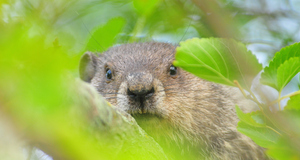From Discussions VOL. 4 NO. 1Gharial (Gavialis gangeticus) Habitat Use and Behavior Analysis in Response to Repeated AggressionDISCUSSIONThe gharial has been stated as being the most timid of crocodilians (Brazaitis 2001). However this may not be the most accurate description. It may be the least aggressive, but not necessarily the most timid due to the fact that the gharial would often orient itself toward the public and continuously swim directly in front of the glass where the visitors stood to watch. One can see this visitor interaction by the results, in which the gharial spent less time resting in the afternoon when the public was present rather than in the morning when there is very little human interaction (Fig. 4a). In fact, very few instances about gharial attacks on humans are recorded in literature. According to minimal research on this topic, the gharials have all been either defending territory or eggs; the gharial has been known to mistakenly take small humans for prey by grabbing an extremity, but the person was then quickly released. There are no recorded deaths due to gharial attacks (Bustard & Singh 1981). This could either be due to lack of information from native people, lack of interaction between gharials and native people, or that the gharial is truly the least aggressive crocodilian. According to keepers and minimal experience in the exhibit during the study, the gharial at the Cleveland Metroparks Zoo is not prone to attacks and can even be hesitant to approach a new person. From the data and the results of this study, and by the fact that stereotyped swimming was reduced, we can see that this particular gharial was stimulated by the presence of people (Fig. 4). The gharial often left what it was doing to swim in front of the glass in the exhibit. One keeper related a story that in the morning when the first large group of people came up to the exhibit, the gharial, previously basking, opened one eye, turned its head toward the public and walked into the water and began swimming in front of the glass. The results of the days with public present versus not present are essentially the afternoon versus morning scans, respectively. The differences could be due to either time of day or presence of visitors. However, based upon the main keeper‟s and observer‟s observations of the gharial, the correlation strongly points towards the presence of people and not to time of day. There are also anecdotes from the keepers in which the gharial stayed active late at night, when the exhibit lights were already off, due to a large party. This would suggest that although it is the time of day in which the gharial is not normally active at the front of the exhibit, the presence of people changed this routine. These pure observational results must be studied further in a more scientific fashion in order to determine the complete significance of these observed behaviors. The only basking that was seen was in the afternoon (Fig. 4a). This is difficult to interpret due to the artificial surroundings. During the winter, gharials are seen basking during all times of the day to maintain their higher body temperatures. In warm months, they are only seen basking in the early morning and retreat to water once early afternoon hits with the warm sun (Whitaker 1982). In a habitat in which artificial lighting and heat are emitted, it is difficult to determine the reason why basking was seen in the afternoon due to the lack of thermometers in the exhibit itself. Therefore, the basking may only be seen once the gharial is more active and able to heave itself onto the land in order to keep itself warm for a portion of the day, but these results are inconclusive. Also, the gharial was never seen basking on the left side of the land. This is most likely due to two things: first, the small size of this portion of land would not provide enough room for the gharial to pull itself onto the land; second, this is also where the gharial is fed, and the keepers noticed that the gharial has only been seen in this section when it is fed. The study began with the intent to determine what in its environment was causing the gharial to attack and kill, but not eat, the fish in its exhibit. During the study, the gharial only killed one tinfoil barb, and it was most likely due to the fact that it was not fed on its proper day since the keepers were waiting to feed it for a television crew that was coming four days after the usual feeding time to use the gharial for education purposes. The day before this was to happen a tinfoil barb was killed, and for the most part eaten. Therefore, no correlations were able to be drawn regarding the gharial‟s interspecial aggression. However, any studies on this species are valuable due to the lack of literature on the gharial. The implications of the study may very well show a social nature of the gharial. They are known to be communal nesters (Rao & Singh 1993), meaning that females may live in social groups. Further research on their behavior in the wild is needed. Due to the dwindling populations, this may not be a possibility, but as the captive-reared specimens are released into the wild it may allow us to discover aspects to their behavior not yet known. The aggression previously noted in this individual may be due to a lack of social stimulation, or even overstimulation due to the amount of other turtle and fish species in the exhibit. In the wild the gharial may choose its location based on water velocity and the relative amount of other animals and availability of a niche. The large volume of turtles in such a limited exhibit may be causing stress. A Callagur turtle was observed biting the tail of the gharial during an observation. Therefore, these constant stressors may be causing the gharial to react in an aggressive manner. The future of the gharial in the wild is as variable as that of captivity. Although restocking programs are now in place in India, mainly the National Chambal Sanctuary (Hussain 1998), habitat destruction continues to occur throughout the gharial‟s native range. Commercial fishing and lack of knowledge of these relatively timid crocodilians have also added to the reduction of populations along the Brahmaputra River (Choudhury 1997). The sanctuaries in India, however, appear to be the only hope for breeding captive gharials as of now. Due to their rarity and negative public response, this species has been neglected in behavioral studies. In order to increase the population of gharials in the wild and those kept for education purposes in captivity, one must better understand its natural habitat and behavior, and this can only be done by further research on the world's least known crocodilian. AcknowledgementsI would like to thank Dr. Kristen Lukas for allowing me to do this project at the Cleveland Metroparks Zoo, keeper Brad Poytner for his assistance and knowledge, and the rest of the Cleveland Metroparks Zoo staff who aided me in this project. ReferencesBrazaitis, Peter. "A Guide to the Identification of the Living Species of Crocodilians." American Zoo and Aquarium Association Professional Training Program: Crocodilian Biology and Captive Management, 2003, Chapter 2. Bustard, H.R. & Singh, L.A.K. "Gharial Attacks on Man." Journal of the Bombay Natural History Society 78 (1981): 610-611. Choudhury, Anwaruddin. "Status of the Gharial Gavialis gangeticus in the main Brahmaputra River." Journal of the Bombay Natural History Society 95 (1998): 118-120. Hussain, Syed Ainul. "Reproductive success, hatchling survival and rate of increase of gharial Gavialis gangeticus in National Chambal Sanctuary, India." Biological Conservation 87 (1999): 261-268. Morgan, Kathleen N. & Tromborg, Chris T. "Sources of stress in captivity." Applied Animal Behaviour Science 102 (2007): 262-302. Rao, R.J. & Singh, L.A.K. "Communal Nesting by Gharial Gavialis gangeticus (Gmelin) (Reptilia: Crocodilia) in National Chambal Sanctuary." Journal of the Bombay Natural History Society 90 (1993): 17-22. Singh, L.A.K. & Bustard, H.R. "Growth and behaviour of a blind gharial Gavialis gangeticus (Gmelin)." Journal of the Bombay Natural History Society 79 (1982): 681-684. Srivastava, A.K. & Bustard, H.R. "Phylogeny and zoogeography of the gharial, Gavialis gangeticus (Gmelin) (Reptilia, Crocodilia)." Journal of the Bombay Natural History Society 92 (1995): 230-233. Vliet, Kent A. "Social Behavior of Crocodilians." American Zoo and Aquarium Association Professional Training Program: Crocodilian Biology and Captive Management, 2003, Chapter 13. Whitaker, Romulus & Basu, D. "The gharial (Gavialis Gangeticus): A Review." Journal of the Bombay Natural History Society 79 (1982): 531-548. AppendixAppendices for this article are available here: Suggested Reading from Inquiries Journal
Inquiries Journal provides undergraduate and graduate students around the world a platform for the wide dissemination of academic work over a range of core disciplines. Representing the work of students from hundreds of institutions around the globe, Inquiries Journal's large database of academic articles is completely free. Learn more | Blog | Submit Latest in Biology |



















